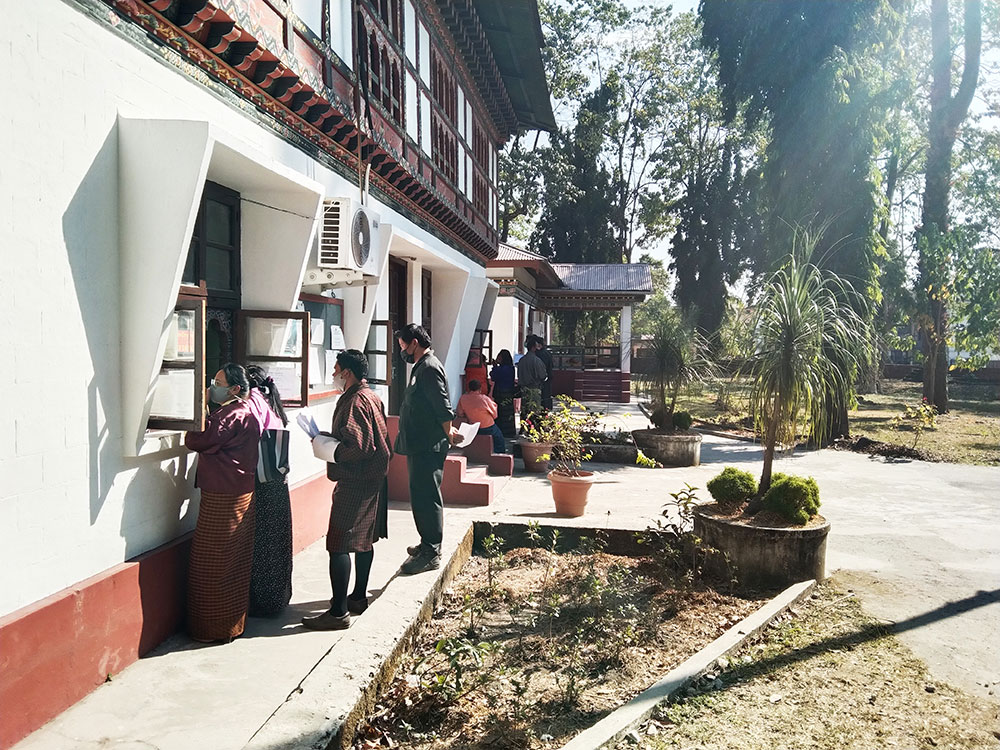Close to 30,000 travelled from Sarpang to low-risk areas in the past nine months
Nima | Gelephu
People make a long queue every morning at the incident commander (IC) secretariat office located at the old drungkhag office in Gelephu, requesting that officials prioritise their quarantine entry.
The situation is getting worse.
Some allege that they were not called for quarantine even after registering a month ago.
At 11am on January 7, a woman pleaded with officials at the IC secretariat for a quarantine seat. She wanted to return to her daughter who will be taking the board exam next month in Paro. The woman breaks down.
However, not a single person was completing the quarantine period that day.
Officials conveyed that the woman would be called immediately in the next batch. It’s the least they could do.
After 20 minutes, another man submitted an application for quarantine, citing his travel as an emergency. The man wanted to attend a marriage ceremony.
Officials returned the application and asked the man to wait for his turn.
The IC secretariat officials said they were struggling to manage seats for people with genuine reasons who have to attend funerals and go for medical treatments.
Records showed that more than 3,000 people, who registered as routine travellers, are waiting for quarantine in Sarpang as of January 7.
Officials said the quarantine facility in Gelephu can take about 70 people daily, but about 300 register for quarantine daily.
There are 30 designated quarantine hotels for routine travellers in Gelephu and Sarpang and 13 hotels are reserved for foreign workers quarantine in addition to the 200-bedded quarantine facility.
An official working at the IC secretariat, Dawa Pelzang, said quarantine is provided on a first come first basis after the registration. “There are more registered people than the quarantine capacity. Emergency cases are facilitated. There are also people from other high-risk areas looking for quarantine facilities here.”
To increase the quarantine capacity, the dzongkhag taskforce started identifying over 20 residential buildings that could be used as quarantine facilities. The team also sent routine travellers to be quarantined in Thimphu and Punakha.
Quarantine officials said starting a quarantine facility in nearby dzongkhags would ease the quarantine pressure.
A 23-bed quarantine facility was inaugurated in December last year in Tsirang but the quarantine facility has yet to provide quarantine services.
Meanwhile, some of the reasons for travel as per the online registration were medical check-ups, examinations, transfers, annual rimdros, personnel work, training, interviews, and baby showers.
Winter, sports programme, and official travel increased quarantine pressure?
More than 26,000 people travelled from high risk to low-risk areas from Gelephu and Sarpang, including 4,000 travellers who were quarantined in Thimphu and Punakha in the past nine months.
The government pays Nu 800 per person a day for the facility quarantine.
According to officials, the number of people registering for quarantine increased because official travel and programmes involving large gatherings from low-risk areas were organised in Sarpang.
The Bhutan Football Federation conducted a selection camp that involved more than 300 students from across the country last month. Many travelled for vacation and to meet their parents during the winter break.
Restrict movement from low-risk areas
A resident from Gelephu said quarantine for routine travellers was not facilitated smoothly. “It’s inconvenient for people. Calls were not well received. There are thousands on the waiting list, which wouldn’t have happened if it was well monitored.”
He said that it is important to restrict people travelling to high-risk areas. “People from low-risk areas can travel easily to high-risk areas, whereas the movement from high-risk areas is restricted.”
He said officials should inform people. “Make them aware that leaving from a high-risk area will be difficult. People with a genuine reason must be allowed to travel to high-risk areas.”


